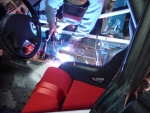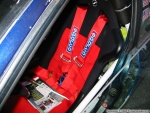Corbeau has released the FX1 line of fiberglass composite race seats as an inexpensive alternative to the more expensive Sparco Evo. While the FX1 is designed for medium sized drivers and is similar in dimensions to the Sparco Evo 2, the FX1 Wide is claimed to be the largest race seat in production with dimensions slightly larger than the Sparco Evo 3.
Many thanks go out to Brett Setliff over at SOLORACER.com for doing the research on these seats before they were released and drop shipping them to Hatch Manufacturing, our cage builder, for installation into our Subaru Impreza rally car the minute they became available! We are quite impressed with the FX1 Wide but, as with any other inexpensive product, we have found a few quirks.


First impressions…big and mean!
First of all, the FX1 Wide seats are absolutely huge! Both my navigator and I had major concerns about finding proper seating due to our 44″ waists and birthing hips. We both had issues just barely squeezing into the Corbeau Forza and the Sparco Evo 2 so we knew we needed to find larger seats. We initially looked at the Corbeau Forza II but decided to wait for the FX1 to be released. We knew we’d chosen the right seats when Brent Hatch of Hatch Manufacturing called us and voiced concerns about physically fitting the seats into the cage!
At first glance, the FX1 Wide appeared to be just as good as the Sparco Evo 3. The fiberglass composite shell is extremely sturdy and slightly flexible with high quality outer fabric and padding. Major friction points are reinforced with leather patches and the colored padding can be removed for washing. As a bonus, additional colored inserts and padding can be installed for a better fit.
Quality/price/performance…choose two!
As with virtually all products, the old adage of you get what you pay for certainly rings true. At $299 and $344 respectively, the FX1 and FX1 Wide can hardly be called cheap. Compared to the more expensive $549 and $599 Evo 2 and Evo 3 seats as well as the $819 Corbeau Pro Sport, however, one has to imagine that the price difference is justifiable. Fortunately, the inexpensive price of the FX1 seems to be due to Corbeau designing the seat on a budget and not cutting corners.
Minor gripes and concerns.
Since the FX1 is a first generation seat and we are some of the first guys in the US to take delivery we fully expected there to be some issues. Most of the issues were quite minor:
- To simplify installation we purchased the Corbeau seat bracket designed to fit the FX1 Wide into our GC8 Subaru Impreza. The holes in the bracket did not line up exactly with the feet on the seat and had to be modified slightly with a die grinder. Corbeau verified that this as a minor issue that happens occasionally.
- The outer fabric on one of the seats let go in shipping and had to be reattached. This was a simple matter of unhooking the removable tension wire and realigning the fabric.
- The glue on one of the plastic harness slot inserts let go and had to be reglued. Since the inserts are flat and the back of the seat is curved it appears that this may be an issue if not enough glue is used to attach the inserts at the factory.
Installation procedure.
Actually fitting the FX1 Wide into a car becomes a game of inserting a square peg into a round hole. Stuffing the FX1 Wide into the GC8 Subaru Impreza chassis required liberal use of a sledgehammer to dent in the transmission tunnel just behind the shifter. Taller drivers who use the seat farther back on the slider may not have a rubbing issue but the fit is still extremely tight. The Corbeau driver seat bracket fit perfectly on the first try and there was plenty of clearance to use both the stock bolts and the eyebolts included with our Sparco six point harnesses to attach the bracket to the chassis.
Since a custom bracket was fabricated to mount the navigator seat as close to the floor and as far back as possible, installation of the harness eyebolts became an issue of chicken and egg. The eyebolt could not be torqued to attach the bracket to the chassis while the seat was on the bracket but, once the bracket was torqued to the chassis, there was not enough clearance to reattach the seat to the bracket. Creative use of physics and folding of the time space continuum, however, allowed everything to be attached properly. We’re still not 100% positive how we got it to work.
Long term comfort and seating position.
It takes some getting used to the new seating position of the FX1 Wide on the Corbeau brackets. Because the base of the FX1 Wide is thinner with less padding than the stock seats the overall seating position is just over two inches lower than stock. This drastically lowers the center of gravity but completely changes the dynamics of driving the car. Adjusting the steering wheel all the way down with the stock seats just barely touched my thighs where I now have over two inches of clearance with the FX1 Wide. Shorter drivers may have an issue with the steering wheel position being too high even in its lowest setting.
Although the padding is much thinner and not as contoured as the Sparco Evo 3 the seats are extremely comfortable, even in a daily driver. Both my navigator and I feel quite at home in the FX1 Wide and I personally have had no comfort issues during both two hour drives and my 30 mile commute to and from work. My navigator has complained of minor discomfort during spirited driving but that can easily be rectified with padded inserts.
Installing the Corbeau FX1 into the Nissan NX2000.
 I installed the Corbeau FX1 in my 1993 Nissan NX2000 with the seat rails supplied by Corbeau. Installation couldn’t have been easier: 1 Philips head screw to take out some trim and four 14mm bolts to get the stock seat out. The FX1 went in just as easily. The Corbeau rails matched up perfectly and, four bolts later, the seat was in! The whole install took no more than 15 minutes.
I installed the Corbeau FX1 in my 1993 Nissan NX2000 with the seat rails supplied by Corbeau. Installation couldn’t have been easier: 1 Philips head screw to take out some trim and four 14mm bolts to get the stock seat out. The FX1 went in just as easily. The Corbeau rails matched up perfectly and, four bolts later, the seat was in! The whole install took no more than 15 minutes.
The seat is very firm, even for a race seat, but all padding is removable and upgradeable. The seating angle is ideal and the shoulder bolstering is perfect. The seat by itself rocks.
Unlike the lower seat rails for the GC8 Subaru Impreza, the seat sits quite a bit higher than stock with the Corbeau sliders for the NX2000. At 6’1″ I have to slouch down if I don’t want my head to hit the sunroof so there is definitely no helmet clearance and, with a harness, I’ll never sit in the seat correctly with the supplied Corbeau seat rails. All this is easily fixed by a using different mounting scheme or fabricating custom brackets by hacking up the stock sliders.
According to Brett Setliff at SOLORACER.com Corbeau also makes sport rails to lower the seating position.